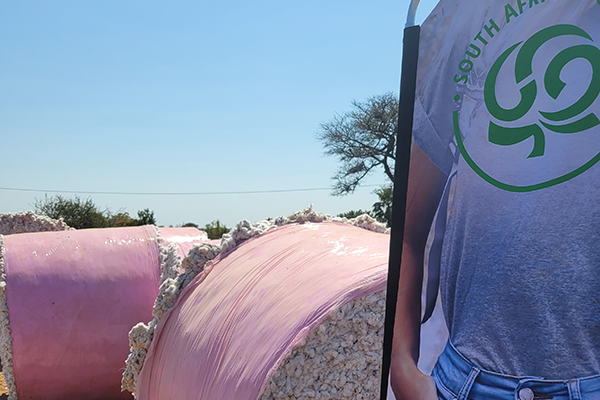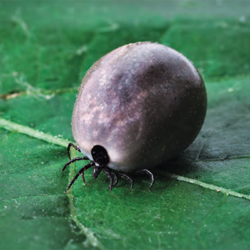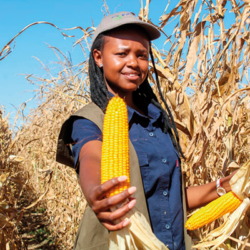Two smallholder cotton communities in Limpopo and Mpumalanga packed their last woolpack by hand in August, after welcoming new baling machines. With automated baling, these communities can look forward to making bigger margins on their cotton crop. African Farming’s Robyn Joubert reports.
It’s a wrap for the 2021-2022 cotton season, with South African smallholder cotton farmers harvesting about 5 972 lint bales for the year ended August 2022. This is a vast improvement from 1 620 lint bales the previous year.
Farmers in Matlerekeng in Limpopo and Nkomazi in Mpumalanga completed their harvest as usual – by hand-packing their seed cotton into woolpacks and sending it off to the ginnery. Yet this might be the last time they do this.
With the handover of two locally manufactured cotton baling machines in Matlerekeng Village on 24 August, the communities were welcomed into the era of mechanised baling. These automated balers produce round, plastic-wrapped bales in line with national commercial standards.
The balers were funded by the Department of Science and Innovation’s (DSI’s) Agricultural Bioeconomy Innovation Partnership Programme in collaboration with its implementation partner, the Technology Innovation Agency (TIA). Cotton SA facilitated the process and Caleidoscope Events was contracted to manufacture the Drawid cotton balers.
The baling equipment makes it quicker and easier for the Matlerekeng and Nkomazi communities to bale, transport and process their cotton crop; and helps build a more competitive and sustainable agricultural economy.
Previously, cotton harvested by the smallholders was delivered to ginneries in inconsistently packed woolpacks. This resulted in additional costs for the ginners, which have mostly modernised their gins to process round bales aligned to the mechanised standards of commercial farmers.
“The machines will enable farmers to conduct primary agro-processing so that they can leverage economies of scale to aggregate their produce into bales, which the gins can accept without additional costs for the smallscale farmers,” said Dr Blade Nzimande, Minister of Higher Education, Science and Innovation.
With the new compacted, round bales, smallholders can load more seed cotton on the interlink truck for transportation, earning an extra R0.73/kg for seed cotton.
“Preliminary investigations indicate that if smallholder farmers can deliver their cotton in round bales, this saving could lead to an additional income of about R1 514.69 per farmer per 2.5ha,” said Tertius Schoeman, Cotton SA transformation and development manager.
In the 2021-2022 season, depending on the grading and quality of their cotton seed, smallholders earned between R10 and R10.50 for seed cotton. This can rise to R11 using the baler as the baled content is cleaner. Hand-packed woolpacks contain 38%-40% cotton lint and 50% seed, with the balance being impurities like dirt and plant material.
Cotton farmer Frans Malela, vice-chairperson of Swara o Tiise Molemi Agricultural Cooperative and regional representative of Cotton SA’s Smallholder Cotton Farmer Forum, expressed his appreciation to Cotton SA and the funders for supporting smallholders with this innovative technology.
“The mechanical baling of seed cotton saves us time and money. We no longer have to buy woolpacks and we save on the handling fee at the gin. The cotton baler wraps the bales much faster than we could pack the bags,” said Frans.
The baling machine can wrap 16 to 18 bales per hour at about 600kg a bale. Any heavier, and it would be a battle to load the bales onto trucks. Commercial bales weigh up to 2,4t.
“The balers are 100% RSA manufactured. One of the reasons we supported a local manufacturer is that if we have a breakdown, we don’t need to import parts. We also followed up with training to teach farmers how to handle the balers and service and maintain the basic parts,” said Tertius.
Maria Swele, chairperson of Swara o Tiise Molemi Agricultural Cooperative, has been farming cotton for 18 years. She is relieved that manual baling is a thing of the past and believes the cooperative will be able to expand production with the help of the technology.
The handover of the automated balers was attended by smallholder farmers and roleplayers.
The balers are 100% locally manufactured so spare parts will not have to be imported in the event of breakdowns.
BETTER TIMES AHEAD
The extra income generated by the balers can have a multiplier effect in terms of socio-economic benefits in the Matlerekeng and Nkomazi communities. At farm level, each smallholder who plants 1ha cotton creates at least 1.35 jobs.
In the 2022 planting season, the Nkomazi machine is expected to benefit more than 880 farmers, with the Matlerekeng machine to benefit 186 farmers in four communities: Matlerekeng, Dichoeung, Nokaneng and Rust de Winter.
About 63% of the Nkomazi farmers are women and about 19% are youth; while about 58% of the Matlerekeng farmers are women and about 10% are youth. All cotton production in these communities is dryland, as farmers do not have irrigation.
Sibusiso Manana, TIA head of agriculture, says the provision of the balers is aligned with TIA’s developmental mandate to support the diffusion of technologies to emerging and smallholder farmers, particularly women, youth and people with disabilities.
Dr Thabang Bambo, DSI deputy director for biotechnology, said the funding of the machines was aligned with the 2019 White Paper on Science, Technology and Innovation, which identifies access to technologies, and enhanced services and processes, as playing an important role in supporting inclusivity and commercialisation of agriculture.
While Cotton SA would like to uplift more communities with balers, it needs funding to do so. “Working together with government and the private sector to support smallholder communities is vital for sustainable develop ment. The Department of Agriculture, Land Reform and Rural Development (DALRRD) is the main source of funding and we are thankful to them for supporting cotton production,” Tertius said.
Ubongwa Cotton Gin in Makhathini Flats has been revamped and is fully functional, thanks to a successful collaboration between Cotton SA, the SAB Foundation, Ubongwa Cotton Gin, the DALRRD KZN and SenAgri.
Smallholder farmers attend Cotton SA training at Nkomazi, Mpumalanga.
THE FUTURE OF COTTON IN SOUTH AFRICA
The overall health of the smallholder industry is currently good. South Africa had 1 175 black smallholders cotton farmers on 2 929ha dryland and 436ha under irrigation in 2021-2022, according to Cotton SA’s recently released annual report.
Even with erratic weather, the yield of 5 972 lint bales (at a weight of 200kg each) was 10% more than the previous year. Smallholders produced approximately 6% of South Africa’s national crop; 80% of which is exported. The cotton price is expected to be comfortably better next year on the local market.
“Cotton SA’s Smallholder Cotton Farmer Strategic Plan aims to increase smallholder black farmers’ participation to 20% of the national crop by 2030,” said Tertius Schoeman, Cotton SA transformation and development manager.
To make the 2030 target, smallholders will need to produce an estimated 9 000 bales this coming season and at least 12 000 bales in 2030. The national crop is estimated at 120 000 bales by 2030.
“This season, we will do 5 600ha dryland and 230ha under irrigation, with about 2 850 farmers. We’ve received funding from government and the private sector, which will contribute towards improvement.”
Maria Swele, chairperson of Swara o Tiise Molemi Agricultural Cooperative (right), and Cotton SA independent communication manager Tanya Aucamp, with a plastic-wrapped bale.
MAKHATHINI FLATS
The number of smallholder cotton growers in Makhathini Flats in KwaZuluNatal is booming. In 2020, there were 118 farmers, there are currently 606, and over 1 900 new farmers have registered for the 2022/2023 season. This leap is the result of the revamping of Ubongwa Cotton Gin; a successful collaboration between Cotton SA, the SAB Foundation, Ubongwa Cotton Gin, the DALRRD KZN and SenAgri.
The SAB Foundation donated R3 million towards the gin upgrades, along with additional funding for inputs to plant 1 435ha dryland cotton with 606 small holder farmers in October 2021. The pro ject created at least 1 940 jobs and secured 9 700 livelihoods in this povertystricken rural area.
In nearby Mkhuze, import and export business SenAgri has partnered with the community to plant 129ha cotton under irrigation. SenAgri purchases cotton from farmers in Mkhuze and Makhathini Flats and pays them weekly. This initiative has generated a buzz about cotton as farmers are assured of immediate cash, whether they are under dryland or irrigation production.
More and more farmers are signing up to plant cotton. In Makhathini Flats, small holders are forecast to plant 4 000ha in the new season, with DALRRD KZN con tributing inputs for 2 000ha and SenAgri contributing seed for another 2 000ha.
Production is also growing in Limpopo, where the signing of a servicelevel agreement between Cotton SA and the Limpopo Agriculture Department (LARD) resulted in 80ha dryland production. A further 670ha of production assistance is planned for October 2022 in the Ephraim Mogale District outside Marble Hall. It still remains that the two major obstacles to the smallholder industry are funding and land size.
“Farmers are battling with average land sizes between 2ha and 5ha. It is very difficult to make a living on anything smaller than 2ha. It’s better than nothing and it puts some food on the table – but it’s not sustainable,” said Tertius.
The industry needs to build on the momentum of the 2022 planting season to expand smallholder production. “Cotton has enormous potential. There is at least 23 000ha of communal dryland and 6 000ha of irrigation land waiting to be planted to cotton nationally,” said Tertius.
Cotton harvested by smallholders is traditionally delivered to ginneries in inconsistent woolpacks. This resulted in additional costs for the ginners, which reduced the paycheck for farmers.
Cotton works well in rotation with sugarcane as it alleviates soil compaction. Here, cotton production takes place next to sugarcane fields in Nkomazi, Mpumalanga.
Hand-picked cotton weighed in the field.
A CASH CROP, NOT A FOOD CROP
Cotton is a drought-resistant crop that supports the livelihoods of many underdeveloped rural communities. Yet it is often not a farmer’s first choice – it’s something they grow when their options are limited or the market makes it financially attractive.
“Cotton is not a food crop but it grows in places where maize, wheat and beans can’t grow in summer. It flourishes in areas like Makhathini in KwaZulu-Natal and Nkomazi in Mpumalanga, and up in the northern parts of the Northwest province where it is very, very hot with summer rainfall. Farmers plant it in October after the rain, when there is nothing else they can plant. It’s a cash crop and channels some income to dryland farmers so they can buy food. It’s different for irrigation farmers who can switch to vegetables in winter,” said Tertius.
Cotton works well as a rotational crop for sugarcane, as it has a tap root that alleviates soil compaction. “We are working hard to get smallholder sugar farmers to rotate with cotton when they take out old sugarcane ratoons,” said Tertius.
The average yield for South African smallholders is 700-800kg/ha. “We’re doing much better than the rest of Africa, which averages 395kg/ha. This is mainly because our farmers may use GMO seed. It is controversial but the yield improvement is clear. Non-GMO farmers need to apply pesticides and herbicides seven to 12 times a season whereas our farmers only spray four or five times,” he said.




